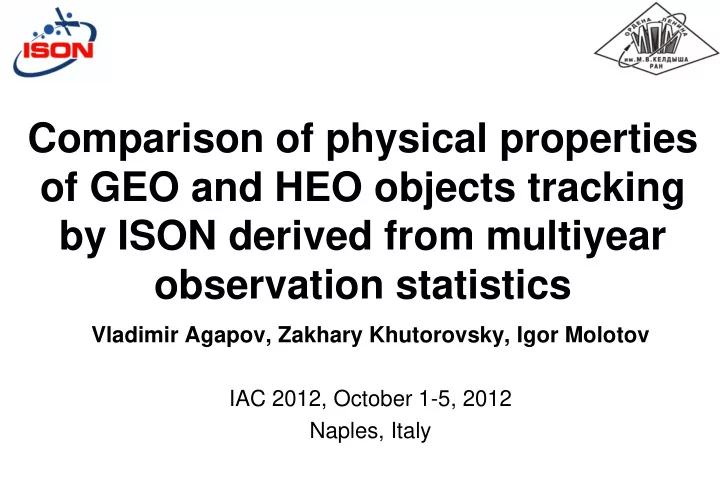

Comparison of physical properties of GEO and HEO objects tracking by ISON derived from multiyear observation statistics Vladimir Agapov, Zakhary Khutorovsky, Igor Molotov IAC 2012, October 1-5, 2012 Naples, Italy
International Scientific Optical Network • ISON is an open international non-government project developed to be an independent source of data about space objects for scientific analysis and S/C operators • Additional scientific goals – discovery and study of asteroids, comets and GRB afterglows • ISON optical network represents one of largest systems specializing in observation of space objects • Cooperation already joins 33 observation facilities of various affiliation in 14 countries, is coordinating by the Keldysh Institute of Applied Mathematics of the Russian Academy of Sciences (KIAM) and maintaining with assistance of ASC “Project - technics ”, JSC
Map of ISON observatories
Quantity of measurements accumulated by ISON instruments (by year) > 10 millions measurements to the date
ISON Monitored GEO Region Objects 01.01.2011 01.01.2012 Total objects in GEO, including: 1557 1704 spacecraft 922 954 active 404 422 non-active 518 532 upper stages and AKMs 257 260 fragments and undetermined type objects 378 490 89 new GEO region previously unknown fragments are already discovered and added to the ISON database in 2012 (as of Oct 1) 7
Distribution of observing GEO objects by period and inclination 8
Distribution of observing GEO objects by RAAN and inclination 9
10
11
12
13
Brightness distribution of observing GEO objects Each object is assumed as a diffuse sphere with albedo of 0.15 Differences between diffuse sphere phase function and real phase function for particular object are ignored Standard brightness (referring to a zero phase angle and 40000 km distance) is calculated for each object based on all collected measurements to the date Objects are split into 3 groups: spacecraft, rocket bodies (upper stages, AKMs), fragments and objects of undetermined type 14
ISON Tracked GEO Objects Distribution by Standard Magnitude – 1704 objects 15
ISON Tracked GEO Objects Distribution by Standard Magnitude – 1704 objects approx. 1 m approx. 10 cm size size 16
ISON Tracked GEO Fragments and Objects of Undetermined Type approx. 1 m approx. 10 cm size size 17
GEO HAMR Objects. How many? 18
ISON Tracked GEO Spacecraft Standard Magnitude vs. Launch Date 19
ISON Tracked GEO Upper Stages Standard Magnitude vs. Launch Date 20
HEO Observations by ISON • Observations of objects at HEO are obtained mostly as an additional output of regular GEO surveys • As of Jan 1, 2012 measurements are collected for 1585 HEO objects, including 270 ones for which data are not provided at SpaceTrack. 78 previously unknown HEO debris are discovered in 2012 (as of Oct 1) • Data are not analyzed yet by category of object (spacecraft, upper stages, fragments) in a manner of GEO objects so only integrated data are presented • Standard brightness (referring to 40000 km distance and zero phase angle, model of a diffuse reflecting sphere with albedo of 0.15) is estimated for all tracked HEO objects 21
Distribution of HEO objects observing by ISON
23
24
25
Conclusions More than 10 millions of measurements (RA, DECL, visual magnitude) are collected within the ISON project since 2003 Nearly 1800 GEO objects are tracked by ISON as of the end of Sep 2012, including ~630 ones without orbital data at SpaceTrack Nearly 1700 HEO objects are tracked by ISON as of the end of Sep 2012, including ~250 ones without orbital data at SpaceTrack Large population of HAMR objects is discovered and studied Brightness properties of tracking GEO and HEO objects are studied and compared. Study is continuing 26
Acknowledgements Great thanks to all ISON observers and engineers, including ASC “Project - technics” employers providing invaluable support in software developing and observation planning Special thanks to the AIUB team for support of continuing multiyear cooperative GEO and HEO debris research especially for HAMR objects 27
Recommend
More recommend